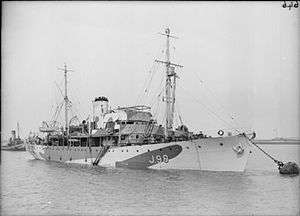HMS Challenger (1931)
 | |
| History | |
|---|---|
| Name: | HMS Challenger |
| Builder: | Chatham Dockyard |
| Laid down: | 1930 |
| Commissioned: | 15 March 1932 |
| Decommissioned: | January 1954 |
| Fate: | scrapped |
| General characteristics | |
| Type: | survey ship |
| Displacement: | 1,140 tons |
| Length: | 220 ft (67 m) |
| Beam: | 36 ft (11 m) |
| Draught: | 12 ft 6 in (3.81 m) |
| Speed: | 12.5 knots (23.2 km/h; 14.4 mph) |
| Complement: | 84 |
| Armament: | None |
HMS Challenger was a survey ship of the United Kingdom's Royal Navy. She was laid down in 1930 at Chatham Dockyard and built in a dry dock. Afterwards she was moved to Portsmouth for completion and commissioned on 15 March 1932.
Service history
Until the outbreak of the Second World War, Challenger surveyed the waters around the United Kingdom, Labrador, the West Indies, and the East Indies. On 23 September 1932, she struck a rock 6 nautical miles (11 km) north of Ford's Harbour, Labrador, in the Dominion of Newfoundland (56°28′30″N 61°10′00″W / 56.47500°N 61.16667°W) and was beached. She was later refloated.[1]
From 1939 to 1942 she served in home waters and as a convoy escort. In June and July 1941 she and three Flower-class corvettes escorted the troop ship Anselm from Britain en route for Freetown, Sierra Leone. When the troop ship was torpedoed north of the Azores, Challenger and the corvette HMS Starwort rescued hundreds of survivors and then transferred them to the armed merchant cruiser HMS Cathay.[2]
From 1942 to 1946 Challenger surveyed in the Indian Ocean and the Western Pacific. She returned to Chatham in 1946 for a refit before returning to the Persian Gulf late 1946. She left the Gulf in 1947 and went to Cyprus where a shore party logged tides. She then proceeded to Gibraltar for another refit in dry dock.
She circumnavigated the World from 1950 to 1953 that included surveying in the West Indies and the Far East. It was on this mission, in 1951 that Challenger surveyed the Mariana Trench near Guam, including the deepest known point in the oceans, 11,033 metres (36,198 ft) deep at its maximum, near 11°21′N 142°12′E / 11.350°N 142.200°E.[3] This point had been named Challenger Deep after it was first surveyed in 1875 during an expedition by a previous HMS Challenger. In January 1954, Challenger returned to Britain, paid off, and was broken up at Dover.
References
- ↑ "Mishap to British survey ship". The Times (46249). London. 27 September 1932. col B, p. 14.
- ↑ Helgason, Guðmundur (1995–2013). "Anselm". uboat.net. Guðmundur Helgason. Retrieved 10 December 2013.
- ↑ Explore the Mariana Trench
Sources
- Gaskell, T.F. (18 March 1954). "Seismic Refraction Work by H.M.S. Challenger in the Deep Oceans". Proceedings of the Royal Society of London. Series A, Mathematical and Physical Sciences. 222 (1150): 356–361. doi:10.1098/rspa.1954.0079.
- Gaskell, Thomas Frohock (1960). "Voyages of HMS Challenger II". Under The Deep Oceans: Twentieth Century Voyages of Discovery. New York: Norton.
- Ritchie, George Stephen (1958), Challenger the life of a survey ship, New York: Abelard-Schuman, OL 6245841M, retrieved 22 January 2012
- Wyatt, A.G.N. (July 1934). "Surveying Cruises of H.M.S.Challenger off the Coast of Labrador in 1932 and 1933". Journal of the Geographical Society. 84 (1): 33–53. doi:10.2307/1786831.